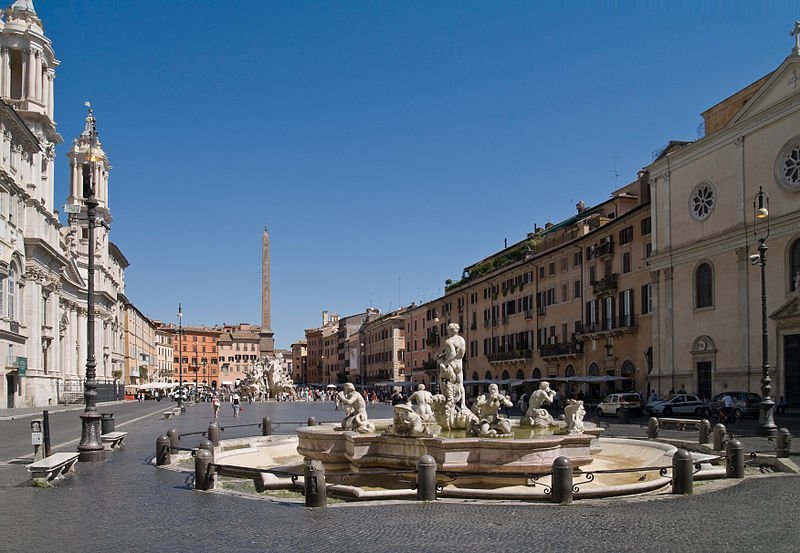Piazza Navona
Piazza Navona: A Roman Gem Between History and Beauty
Close to the Pantheon, the square was built on the ruins of Domitian's Stadium, dating back to the 1st century AD. The square still preserves its original shape. At the time, athletic competitions, games, and horse races were held there. The square is adorned with three beautiful fountains, the most famous being the Fountain of the Four Rivers, built by Bernini in 1650. It stands in front of the Sant’Agnese in Agone church. Each statue of this fountain represents one of four major rivers from four different continents: the Nile for Africa, the Rio de la Plata for America, the Ganges for Asia, and the Danube for Europe. A majestic obelisk proudly rises in the center.
Piazza Navona is an essential stop when visiting Rome. Around the square, you’ll find numerous restaurants, street vendors, and shops. Whether by day or night, take the time to sit on a terrace and enjoy the gentle rhythm of Italian life.
Piazza Navona is located halfway between 9Hotel Cesàri and the Vatican—a perfect spot to take a break and unwind during your day of exploration in Rome.
History of Piazza Navona
Piazza Navona is one of the most iconic squares in Rome, Italy. Located in the city’s historic center, it attracts millions of visitors each year. The square has become a symbol of Rome thanks to its unique architecture, stunning fountains, and historical churches.
The square was originally built in the 1st century AD on the site of Domitian’s Stadium, which could hold up to 30,000 spectators and was mainly used for chariot races. When the Renaissance blossomed in Rome during the 15th century, the square was redesigned by several renowned artists, including Gian Lorenzo Bernini, who created the famous fountains that still decorate the square today.
Shaped like a large oval, the square measures approximately 240 meters long and 65 meters wide. It is lined with cafés, restaurants, boutiques, and historic buildings. The most famous of these is the Church of Sant’Agnese in Agone.
The Fountains of Piazza Navona
The Fountain of the Four Rivers, or Fontana dei Quattro Fiumi, is the most famous fountain in the square. It was built in 1651 by Gian Lorenzo Bernini. The fountain features four statues representing the greatest rivers known at the time: the Nile, the Ganges, the Danube, and the Rio de la Plata. Each river is symbolized by a god or goddess. At the center stands an Egyptian obelisk, brought to Rome by Emperor Domitian.
Another notable fountain is the Fountain of the Moor (Fontana del Moro), located on the southern end of the square. It was designed in 1575 by Giacomo della Porta. This fountain features a statue of a Moor wrestling with a dolphin.
The third fountain, the Fountain of Neptune (Fontana del Nettuno), was also designed by Giacomo della Porta, in 1574. The fountain features a statue of Neptune, the Roman god of the sea, surrounded by tritons and dolphins.
The Church of Sant’Agnese in Agone
In addition to its fountains, Piazza Navona is home to the Church of Sant’Agnese in Agone, one of the square’s most important buildings. This Baroque church was built in the 17th century on the spot where Saint Agnes is believed to have been martyred in the 3rd century.
Construction began in 1652, under architect Francesco Borromini. However, due to disputes with the original patron, construction was halted in 1657 and later resumed in 1659 under Cardinal Giovanni Battista Pamphili, who hired Carlo Rainaldi to finish the work. The church was finally completed in 1672.
The church is known for its spectacular baroque architecture, adorned with marble, frescoes, and sculptures. Its exterior features columns and statues, and the main façade is crowned by a triangular pediment with the coat of arms of Pope Innocent X, who commissioned the construction.
Inside, the walls are richly decorated with frescoes depicting scenes from Saint Agnes’s life, alongside angels and saints. The ceiling is also covered in frescoes, creating an illusion of depth and grandeur.
The main altar showcases a large marble and bronze altarpiece depicting the martyrdom of Saint Agnes, flanked by two angels. Surrounding it are sculptures of the four Evangelists, along with Saints Peter and Paul.
A highlight of the church is the Chapel of the Virgin, which holds a relic of Saint Agnes and a Byzantine icon of the Virgin Mary, believed by many to be miraculous.
Piazza Navona Throughout the Year
Christmas
During the holiday season, Piazza Navona transforms into a lively Christmas market (Mercatino di Natale). Visitors can find traditional decorations, handmade gifts, seasonal food, and hot drinks. The square is beautifully lit, creating a magical festive atmosphere.
Epiphany
On January 6th, Rome celebrates the Epiphany with a religious procession that ends at Piazza Navona. During this event, the Pope traditionally blesses the statues of the Three Wise Men placed in the square.
Carnival
Piazza Navona is also a central location during Carnival. The square comes alive with music, dancing, and street performances, while food and drink typical of the Italian Carnival are widely available.
Spring
In the spring, Piazza Navona hosts open-air concerts and festivals. Visitors can enjoy classical music, jazz, or Italian pop music, while soaking up the sun and the beauty of the square.
Summer
In summer, the square is a popular stage for street performers. Jugglers, acrobats, and musicians entertain passersby with captivating shows. Cultural events such as art exhibitions and outdoor film screenings also take place here.
Autumn
Autumn brings gastronomic events to Piazza Navona, like local food festivals and wine tastings. Concerts of classical and jazz music are often held in the historic churches surrounding the square.
Nearby Attractions
Piazza Navona is surrounded by many other must-see landmarks. Just a short walk away, you’ll find the Pantheon, an ancient Roman temple now converted into a Catholic church. Also nearby are the Trevi Fountain, a spectacular baroque masterpiece built in 1762, and the Piazza di Spagna, home to the famous Spanish Steps and the Fountain of the Barcaccia.
Dining and Relaxing at Piazza Navona
The square is also known for its cafés and restaurants. Visitors can sit at one of the many outdoor terraces to enjoy a coffee or a traditional Italian meal with a stunning view. From open-air cafés to fine dining, and from artisanal gelato shops to traditional pizzerias, the options are endless.
Piazza Navona is a must-see during any trip to Rome. This beautiful square captures the history, art, and vibrant life of the Eternal City. Admire Bernini’s world-famous fountains, visit the majestic Sant’Agnese in Agone, and relax with a drink or a meal while taking in the lively Roman atmosphere. With its timeless charm and festive energy, Piazza Navona is an unforgettable destination.


